🤓 The 2026 Local Search Ranking Factors are here!! Check out the report!
🤓 The 2026 Local Search Ranking Factors are here!! Check out the report!

We’ve all seen it – that sneaky competitor with hundreds or thousands of perfect five-star reviews. They seem to just keep rolling in endlessly day after day. You just know something is fishy.
Well, you’re probably right.
Unfortunately review spam is rampant on Google. Last year, Google even released a spam update to fight this growing problem. Unfortunately, many businesses have noticed an unintended side effect: filtered reviews.
In Google’s own words:
“Google uses automated spam detection measures to remove reviews that are probably spam. These measures help improve people’s experiences on Google and ensure the reviews they see are authentic, relevant, and useful. Some legitimate reviews may be inadvertently removed.”
However, as a regular contributor and Gold Product Expert on Google Business Profile Help Community, I can attest to the fact that this is actually “many legitimate reviews.”
For whatever reason, Google can’t seem to figure it out. Egregious review spam is getting through the cracks, while genuine customer reviews are getting wiped.
Head over to GBP Help Community on any given day and you’ll be sure to see a post just like this: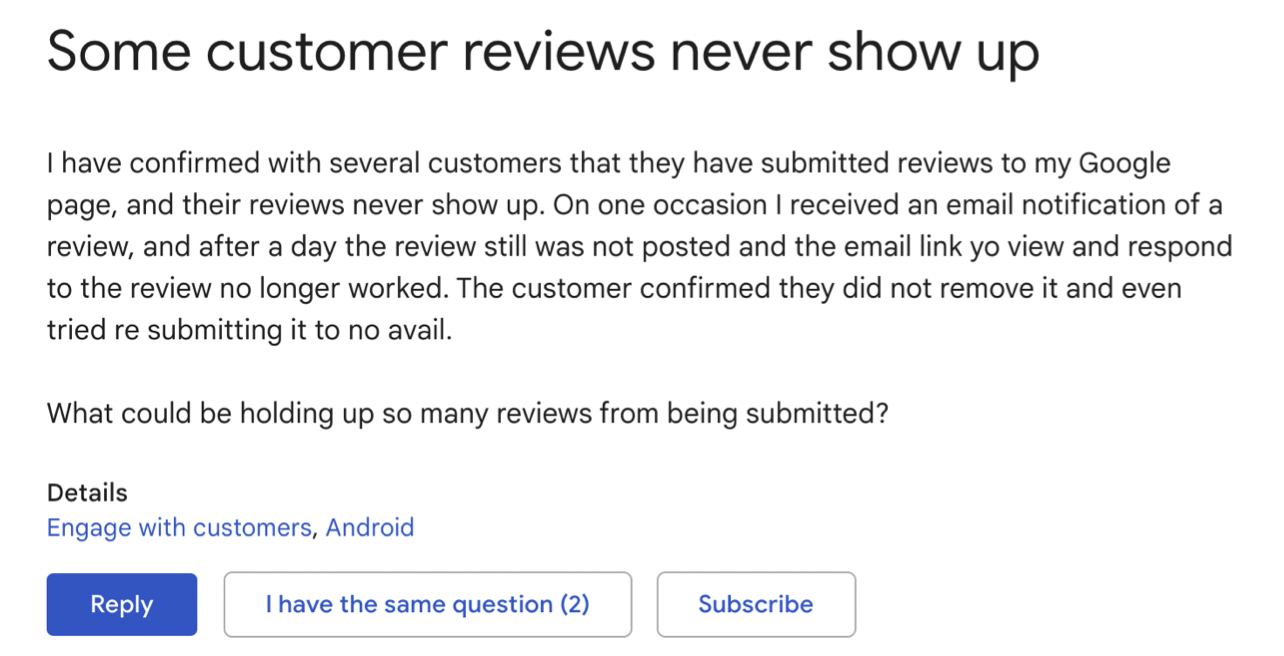 Meanwhile, you’ll be just as likely to find a Google Business Profile just like this:
Meanwhile, you’ll be just as likely to find a Google Business Profile just like this:
Fake review spam is a huge problem on Google, and it’s getting worse with AI-generated reviews.
Check out this egregious example.
What do you think Google needs to do to solve this problem? pic.twitter.com/pWCIvWshav
— Darren Shaw (@DarrenShaw_) May 8, 2023
This might be due to Mike Blumenthal’s theory at Near Media: that Google’s Spam detection AI was trained on a limited set of confirmed spam. If reviewers or Business Profiles have patterns similar to those in this limited data set, their reviews are automatically filtered.
This could explain why evolving spam methods, such as AI reviews, can’t be caught, while real reviews and genuine businesses take the brunt.
Leaving aside the “Why” – what can you do about it?
You may feel powerless against that cheating competitor (or competitors). Maybe you’ve even flagged their profile or reached out to GBP support to no avail.
Good news: You can fight back. You might just need to get your hands dirty.
Google won’t do the work for you, so you’ll need to build a case.
I know it can be frustrating or seem unfair, but it’s Google’s sandbox after all. In this strategy, we’ll break down exactly how to find a cheater and the types of proof you’ll need to show Google for them to finally take action.
Before you dive down this rabbit hole and go full spam ninja, you’ll want to prioritize.
As my personal strategy, rather than reporting every bit of spam I can find, I want to find the ones that will have the biggest impact for my clients.
The golden nugget will be a spam listing ranking third in the Map Pack for a query with my client ranking 4th. In this scenario, knocking a spammy cheater down by even just one position (or even altogether) can more than triple my client’s clicks in that locale. (It’s estimated Map Pack accounts for 44-61% of total clicks for a given query)
Tip: Distance is one of the top ranking factors for Google Map Pack, especially for “near me” terms. The Map Pack may completely change within a few miles or even a few blocks in a city. To be efficient with spam fighting, be sure you are also tracking hyper-local rankings – not just cities.
There are a few ways to get started.
In your Whitespark campaign, be sure you are tracking from multiple zip codes, not from just the city centroid. Start with the zip code of your business, then add some surrounding zip codes.
As mentioned, an ideal scenario will be when my client is 4th in a zip code. I know I could potentially get a quick win. Most of my clients are less concerned with their ranking reports – they just know if their phone is ringing. By prioritizing my spam effort in this manner I can ensure the quickest real-world business impact for my clients.
Once tracking relevant keywords and zip codes, head over to Local Rank Tracker. Filter by “Google Maps” view and scroll down to the list of tracked keywords.
Look for columns where you are ranking 4th: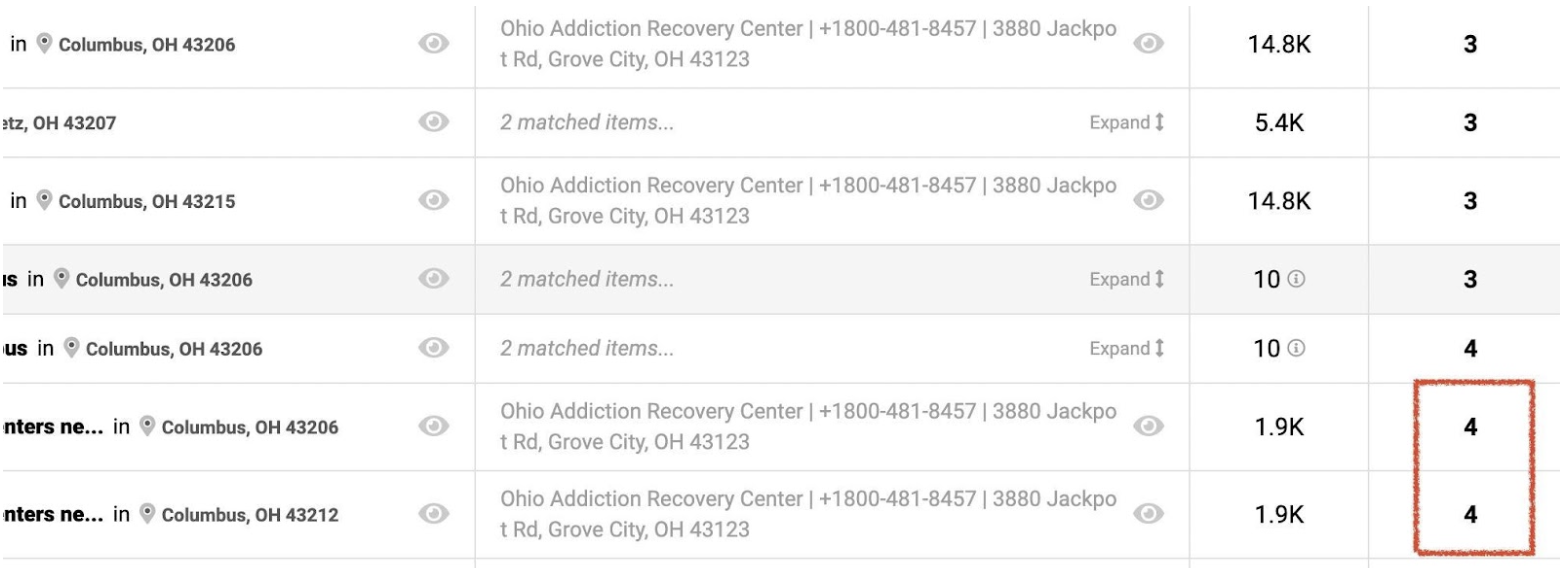 Bingo! High volume terms where my client ranks 4th. This is where I start.
Bingo! High volume terms where my client ranks 4th. This is where I start.
Click the eyeball icon next to a keyword and you’ll then see a full list of all of the competitors and Maps rankings for that query in that zip code. It looks like this: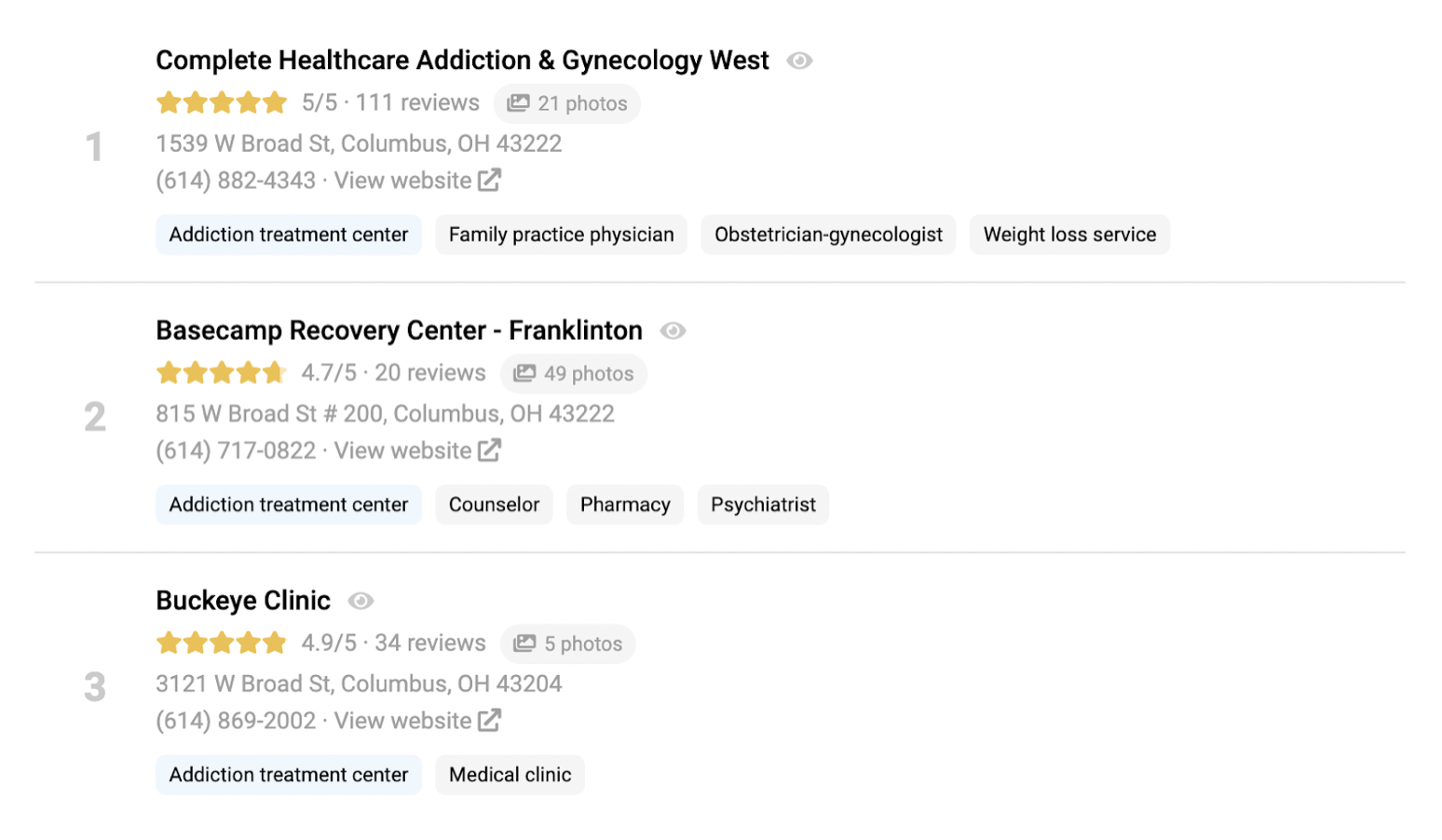 You’ll want to examine all these competitors for every Map Pack for every zip code you track. Prioritize them in order by keyword volume and how close your business or client is to the Map Pack.
You’ll want to examine all these competitors for every Map Pack for every zip code you track. Prioritize them in order by keyword volume and how close your business or client is to the Map Pack.
Once you have your targets, now is when you put them under the microscope.
[jump to step 2]
An alternative to the above method I like to use is grid trackers. Many SEO tools offer grid trackers now.
Grid trackers can show me hyper local rankings in an easy to digest visual.
In this example, I’ll use Local Falcon.
In Local Falcon, you can set a keyword and Business Profile you want to track. Then you set a grid over your city and specify how many miles and pinpoints you want in your grid, such as 5×5, 10×10, 15×15, etc.
It looks like this: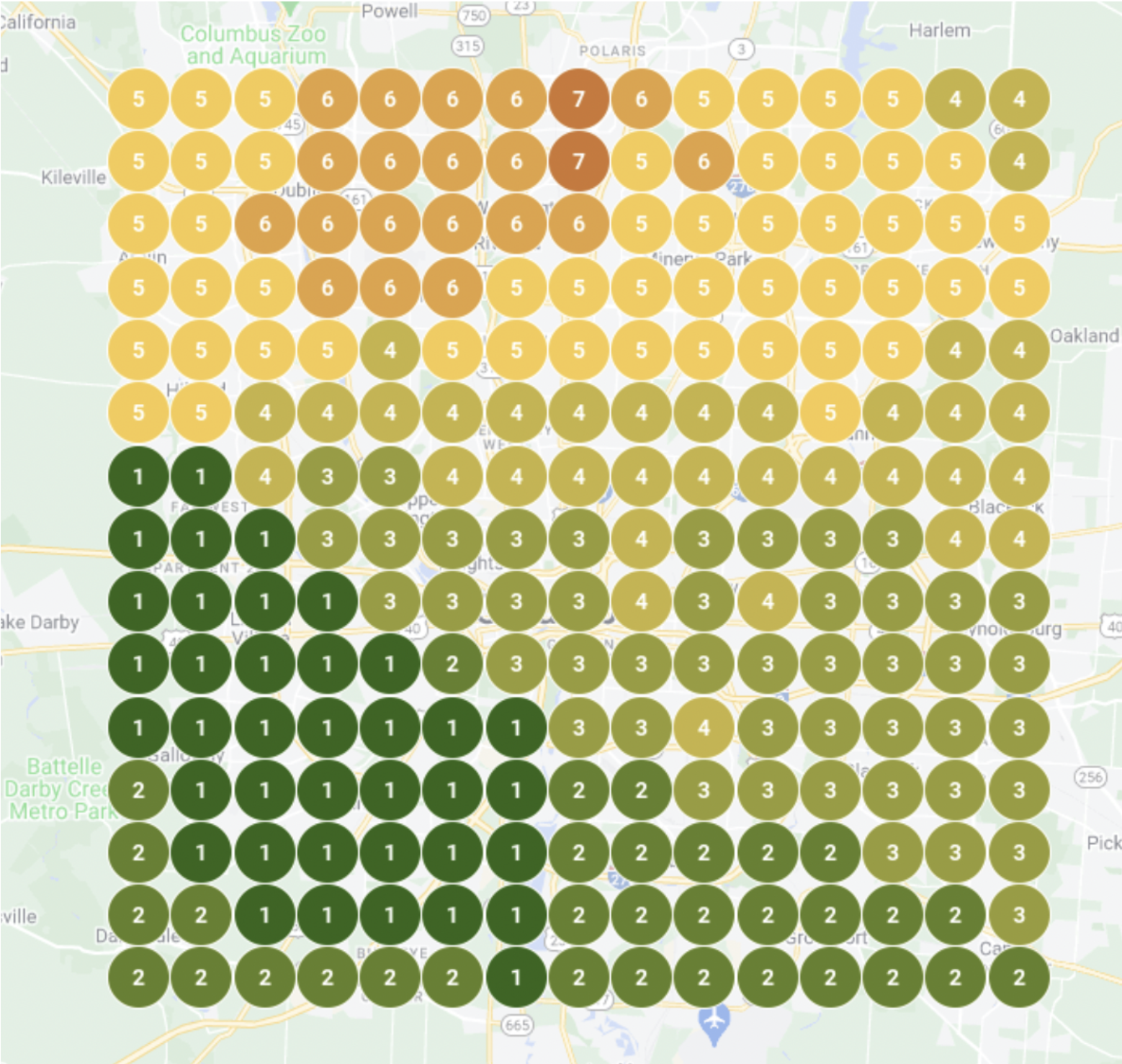 Once you’re tracking and have your grid, you can quickly identify pinpoints of focus. Again, if I see a pinpoint with a “4” – this is where I start, and I move down from there.
Once you’re tracking and have your grid, you can quickly identify pinpoints of focus. Again, if I see a pinpoint with a “4” – this is where I start, and I move down from there.
Similar to Whitespark, if I click on a pinpoint, I’ll quickly see who is in the Map Pack in that neighborhood.
Now I just gather my list of competitors I will investigate for each keyword.
Now you’ll want to dial in a shortlist.
I typically just start with the eyeball test. Competitors with not many reviews or poor reviews probably don’t have review spam.
That said, I still examine their profile for other violations. Is their business name accurate? Is their public address at a commercial building with signage? Is it a virtual office? If you locate violations, you can file a redressal complaint.
If I see a competitor with a lot of very good reviews, then I’ll start to look a little closer. For this, I recommend the Chrome extension GMB Everywhere. It’s free but with limited scans per day, though you can purchase an unlimited plan for less than $100/year.
With GMB Everywhere, you can do a quick review audit. GMB Everywhere will scan all of the reviews and show you the timeframe in which they were gathered and their average rating over time.
Look out for suspicious patterns. Their helpful review audit graph can give you an idea if it’s worth your time to build a case.
Here’s an example graph of a normal Google Business Profile: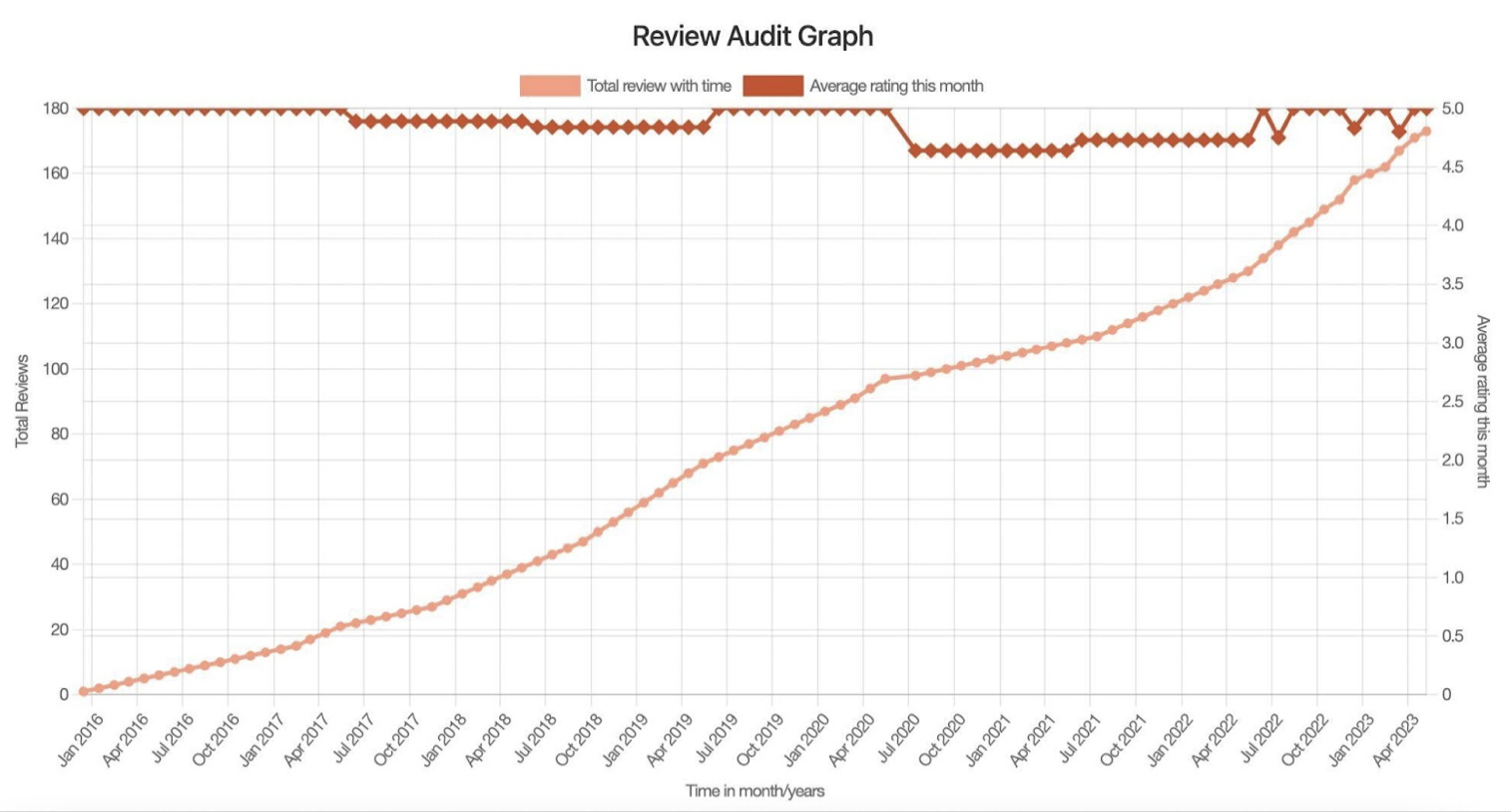 In this example, over 7 years, reviews increase at a relatively consistent velocity. They have 173 reviews over that span. I’d consider this to look pretty normal and not suspicious.
In this example, over 7 years, reviews increase at a relatively consistent velocity. They have 173 reviews over that span. I’d consider this to look pretty normal and not suspicious.
However, some red flags might include:
Here are some examples to look out for: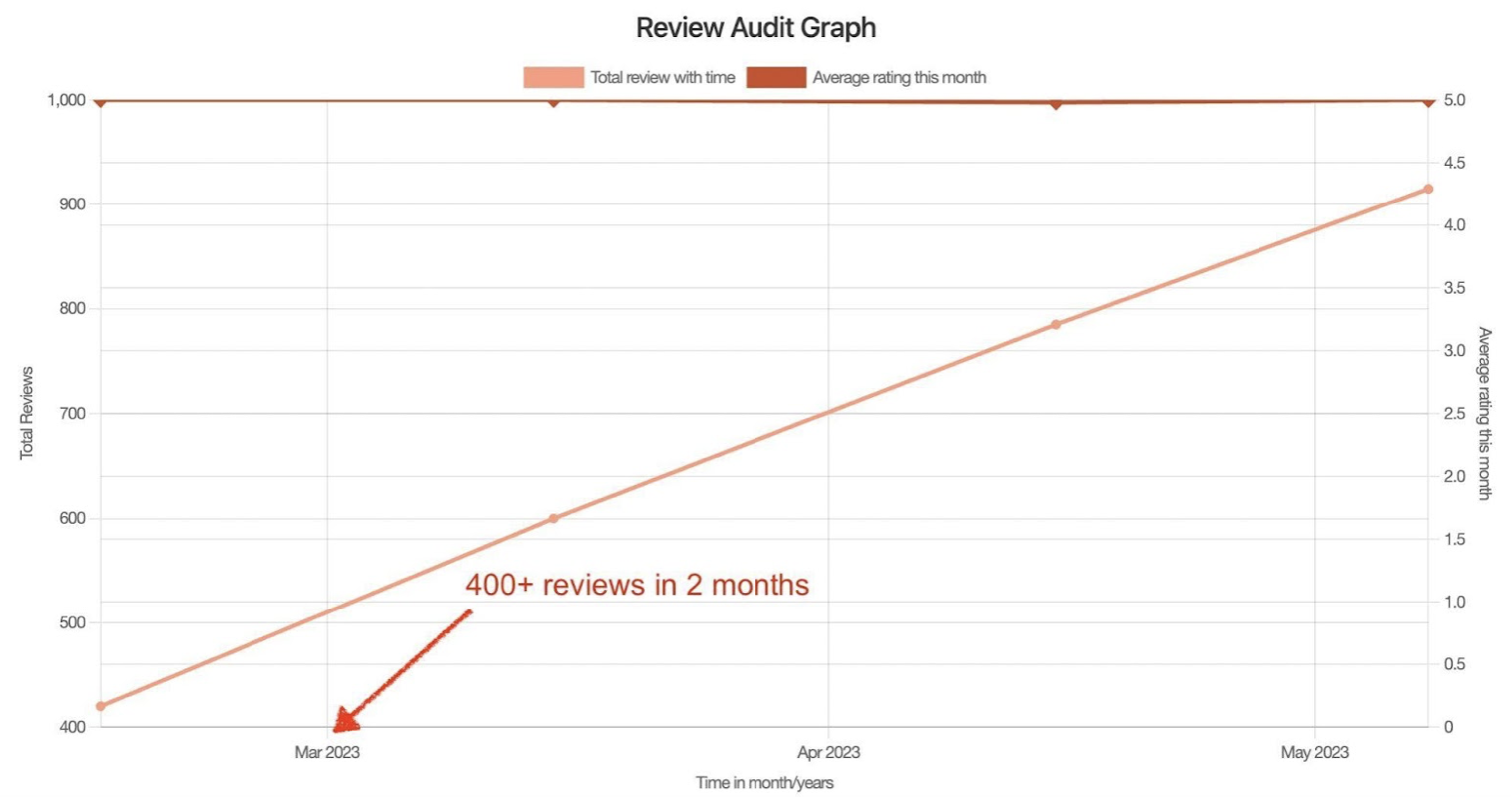 This business has been open for over 6 years, however, most of their reviews (over 900) were gathered over the span of a few months 🚩🚩🚩🚩
This business has been open for over 6 years, however, most of their reviews (over 900) were gathered over the span of a few months 🚩🚩🚩🚩
Here’s another potential cheater: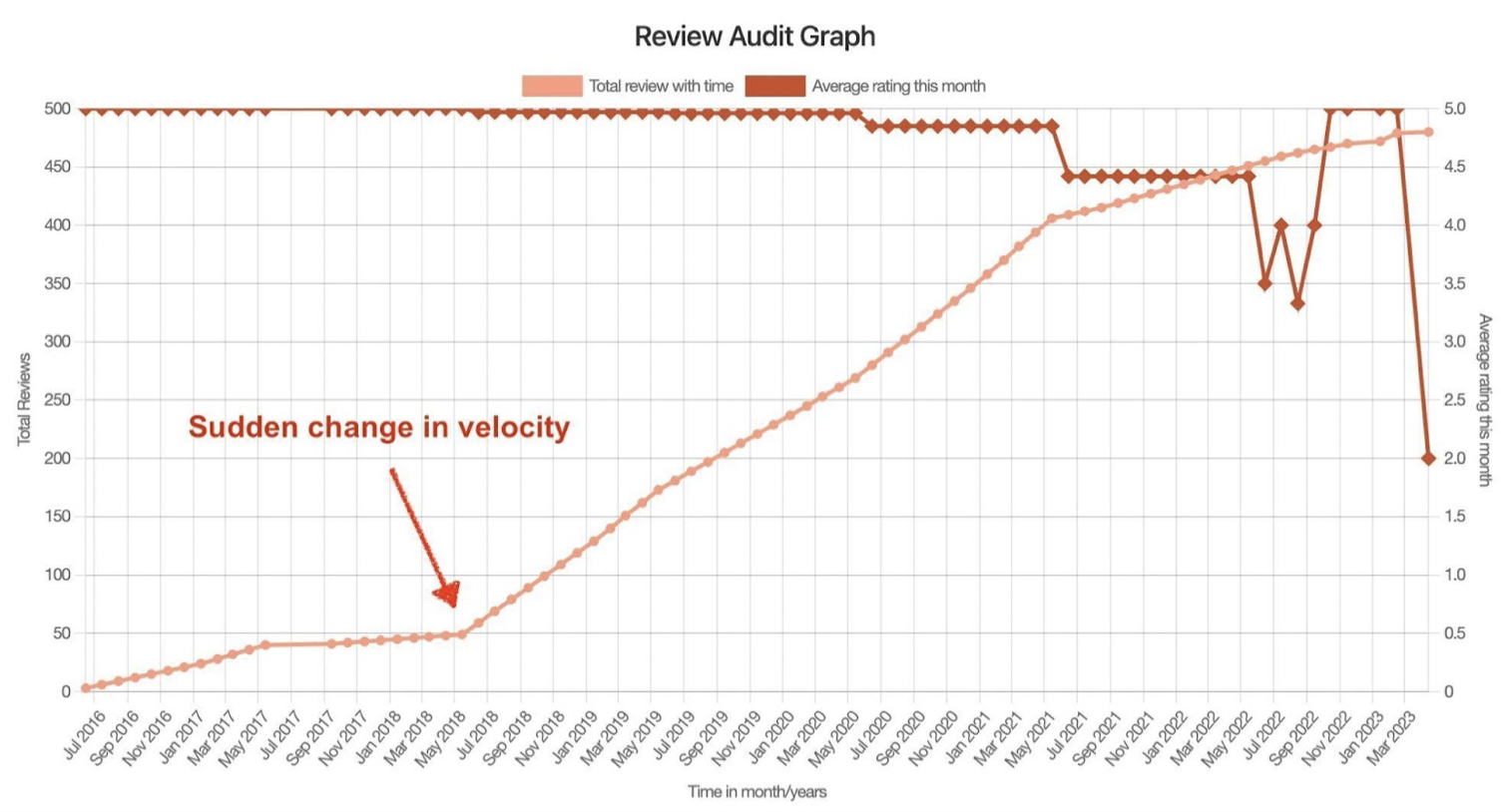 Look out for sudden jumps on the graph. If their review velocity looked pretty consistent, then suddenly picked up the pace in a very short time frame, this is worth investigating further.
Look out for sudden jumps on the graph. If their review velocity looked pretty consistent, then suddenly picked up the pace in a very short time frame, this is worth investigating further.
However, keep in mind this example may not be cheating. Perhaps they just got better at asking customers for reviews. It’s certainly worth adding to your shortlist though.
Now that you have your shortlist of potential review spam, the next step is to build a case that you will eventually show to Google.
To increase your chances of success, you’ll want to gather as much specific evidence as possible to put Google in a position where they feel forced to take action.
Specifically, Google likes to see patterns. There are a variety of patterns to look for. These can range from the reviewer’s location, patterns on each reviewer’s profile, patterns in language, patterns in review time, and more.
Rather than telling Google to inspect all of the reviews on a given profile, you’ll want to specifically show them the reviews in question. This will give you a greater chance of action.
This can take some time, but the results will be worth it. So put on your Sherlock Holmes hat and get ready to build an epic case.
Here are things to look out for:
When you click on a reviewer’s name, you can see their history of contributions to Google Maps.
You’ll see something like this: Real people usually have their review history contained to specific localities ( where they live).
Real people usually have their review history contained to specific localities ( where they live).
Spam accounts like to leave reviews all over the world. Keep an eye out for many reviewers who leave reviews all over the world, or maybe if many accounts seem to be outside the city of the business. Or maybe many reviews come from the same city. These are all suspicious patterns.
Another thing to look out for in review history is what businesses the accounts left reviews for. Spam accounts often leave reviews for the same businesses. Notate how many reviewers reviewed the same business.
Notate the pattern and the name of each reviewer in that pattern. Save this in a document or spreadsheet. Here is an example template you can use.
For this same reason, some spammers have gotten privy to this obvious spam pattern, so they turn their review history off. If that’s the case, you’ll see something like this: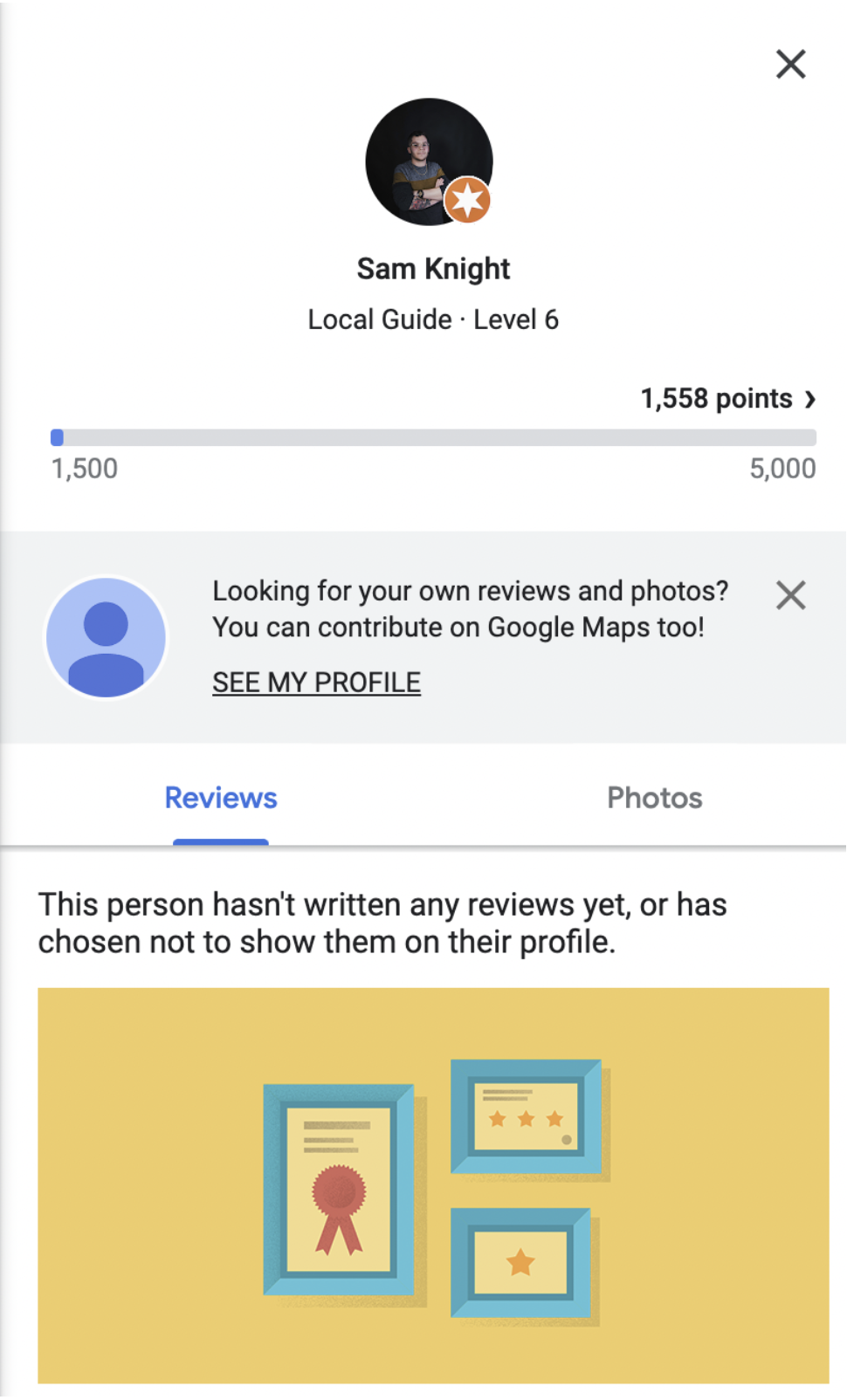 This is a feature that isn’t super obvious or easy to find in your Google account. Many contributors don’t even know it exists.
This is a feature that isn’t super obvious or easy to find in your Google account. Many contributors don’t even know it exists.
For that reason, this can equally be a pattern of spam in and of itself. Google knows not many accounts activate this feature. If all or most of the reviews on a given Google Business Profile have this feature activated, that is a very big 🚩
Notate this all in your evidence doc and the percentage of reviewers that have this feature activated.
Does every single reviewer only have a history of 2 reviews? Or maybe 1 review? If they all have the same review count, this can also be a pattern of abuse.
Notate in your evidence document the percentage of reviewers with the exact same number of reviews in their review history.
Review spammers also like to use similar language. This may be due to AI bots or laziness, but certain grammatical patterns or vocabulary can be sure signs of spam. You may even see completely duplicated reviews that were copy and pasted.
For this, GMB Everywhere can be useful again. In their review audit, they show common terms in reviews.
Here’s an example: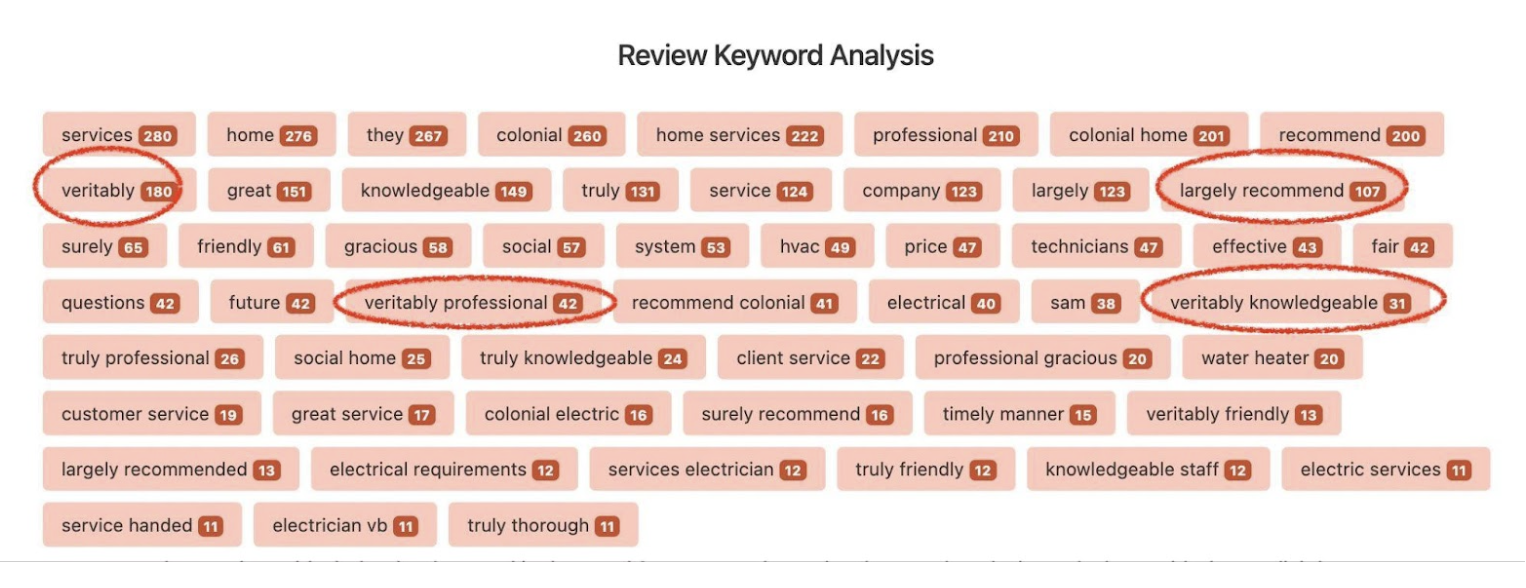 On this Google listing, I noticed some very odd patterns. 107 reviews say they would “largely recommend” the business (???).
On this Google listing, I noticed some very odd patterns. 107 reviews say they would “largely recommend” the business (???).
They also, for some reason, like the word “veritably” – veritably knowledgeable, veritably friendly, veritably professional. Again, this isn’t normal.
You can also use the eyeball test. You may notice a pattern of reviews giving a very specific example of customer service or a particular product. Or you may notice reviews use very similar keywords to manipulate rankings. If you notice a pattern, you can find them all by scraping their reviews (more on that later).
Once you’ve examined and read all of the reviews, notate all those patterns! A rule of thumb is to imagine you are explaining it to a 5th grader. Google processes many complaints and reports, so you want to make it easy to understand and hard to ignore.
An example for your notes could be:
GMB Everywhere can give you a pulse on review velocity and patterns, but when building your case, you’ll want to get more specific.
For this, you’ll want to scrape all of the reviews from the profile. There are various tools for this. I use Outscraper.
There is a free tier but it limits how many reviews you can scrape. However, it’s a fairly cheap service if you decide to buy credits. On my most recent scrape, I scraped a profile with over 900 reviews. It cost less than a dollar.
Once I run my scan, Outscraper spits out an excel sheet with all of the reviews, the review text, dates, time stamps, review IDs, and more. It looks like this: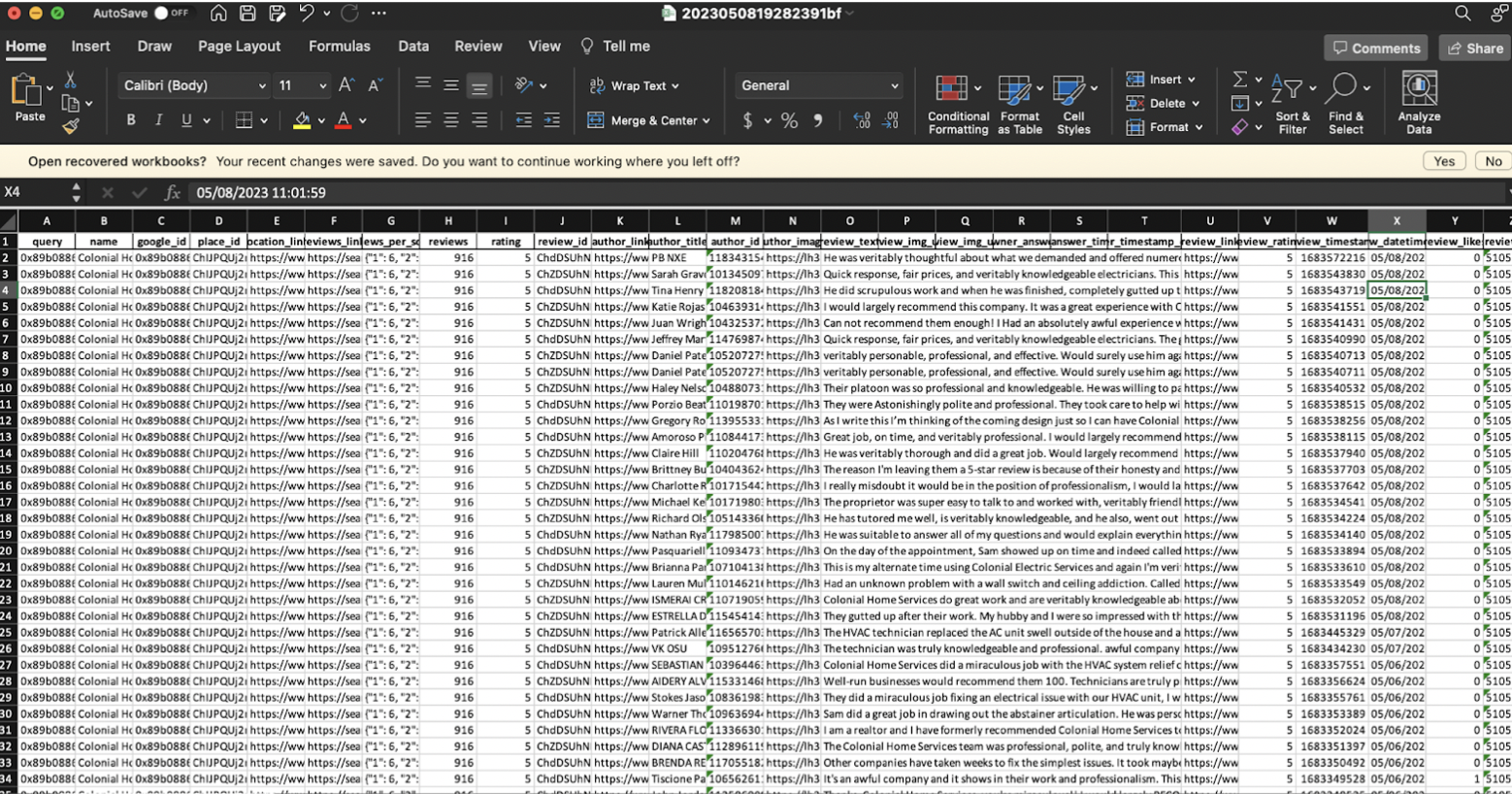 Pretty nifty!
Pretty nifty!
From here, I can locate how many reviews were left in a single day or a single hour. I can also see if the reviews always come in at the same time of day. If I haven’t beaten the dead horse enough: patterns!! Find them and notate.
Now that you have notated all of your patterns and evidence, you want to make a list of all of the reviews that appear to be fake.
Go back to your spreadsheet with your scraped reviews. Find all of the reviews that fit within the patterns you have identified and copy the review ID column. The review ID is an alpha-numeric string, eg. ChdDSUhNMG9nS0VJQ0FnSUN4MEo2M3N3RRAB
Transfer each review ID to your spreadsheet with your other evidence of patterns.
Lastly, explain the impact this review spam has on other local businesses. Google is more keen to take action when the cheaters are harming other businesses with their practices (aka, actually ranking well)
If the business is ranking in the Map Pack and appears to be performing well, it’s worth including a list of other genuine businesses that are impacted by the cheater. Feel free to include screenshots of their Map Pack rankings.
Congrats! You now have a complete list with the necessary evidence to show Google. 
Head over to the Google Business Profile Help Community to create a post.
In your post, you can mention how you have located a business that appears to be getting fake positive reviews, and that you already have the evidence. Drop the share link to your Google Sheet.
Try to refrain from posting Personal Identifiable Information (PII) for yourself or the business in the post body, because Google Help Community threads are indexed. Instead, keep all of this information in your Google Sheet, which helps prevent indexation of PII.
Try to also refrain from pleading or writing a novel and stick to the facts. The community is moderated by volunteers who are not Google staff. We already understand your pain. It helps us when we can quickly see the problem so that we can take action.
An example could be:
“Subject: Business With Many Fake Reviews (Evidence Included)”
Hello PEs
I noticed a concerning pattern and suspect fake reviews on a business.
I have included all of the evidence in this Google Drive [provide the share link to a Google Drive or Google Sheet with your evidence and business in question]
I was hoping one of you could take a look and please escalate this profile if warranted. I’m very concerned this business is manipulating Google rankings and customers with fake reviews.
Thank you”
A Product Expert will chime in to review your evidence and escalate your case.
If the business has other violations, such as a spammy business name, I would also recommend filling out a redressal complaint. Be sure to also mention the fake reviews.
Save the case ID. If you don’t hear from Google in a few weeks, you can come back to the community and ask for an update or an escalation.
From here, you’ll just need to wait for an update from the Product Expert.
While you wait, if you notice new fake reviews keep flowing in, you can go back to your Help Community thread and update the Product Expert. Google can lock profiles from getting new reviews.
Maybe. I’ve seen some profiles get suspended, while others just have reviews removed or their profile locked. I speculate there is a threshold of violations before Google suspends a profile for purchasing fake reviews.
Be sure to update the Product Expert of any additional violations and case ID’s you have for redressal complaints.
Hopefully, Google gets a hold on this problem soon. We all know genuine businesses who follow the rules take the brunt. Until then, I hope this guide gives you the tools to fight back and save your Google rankings.
This is a guest post from our friend and superstar spam-fighter, Sam Knight.
Sam is a Gold Product Expert for Google Business Profile, a local SEO consultant, and the Director of Digital Marketing at an addiction treatment center in Columbus, OH.
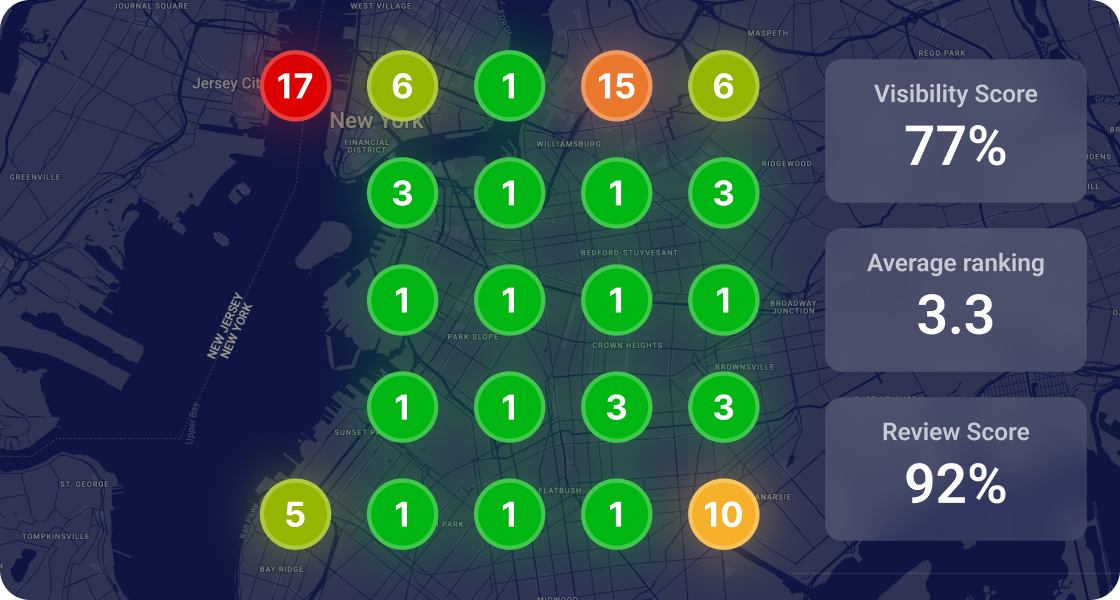

Whitespark provides powerful software and expert services to help businesses and agencies drive more leads through local search.
Founded in 2005 in Edmonton, Alberta, Canada, we initially offered web design and SEO services to local businesses. While we still work closely with many clients locally, we have successfully grown over the past 20 years to support over 100,000 enterprises, agencies, and small businesses globally with our cutting-edge software and services.